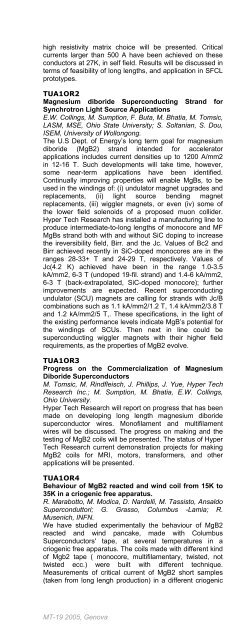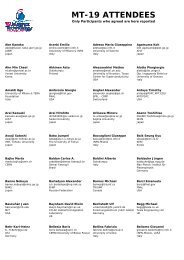Click here to download the abstract booklet in pdf format - MT19 - Infn
Click here to download the abstract booklet in pdf format - MT19 - Infn
Click here to download the abstract booklet in pdf format - MT19 - Infn
Create successful ePaper yourself
Turn your PDF publications into a flip-book with our unique Google optimized e-Paper software.
high resistivity matrix choice will be presented. Critical<br />
currents larger than 500 A have been achieved on <strong>the</strong>se<br />
conduc<strong>to</strong>rs at 27K, <strong>in</strong> self field. Results will be discussed <strong>in</strong><br />
terms of feasibility of long lengths, and application <strong>in</strong> SFCL<br />
pro<strong>to</strong>types.<br />
TUA1OR2<br />
Magnesium diboride Superconduct<strong>in</strong>g Strand for<br />
Synchrotron Light Source Applications<br />
E.W. Coll<strong>in</strong>gs, M. Sumption, F. Buta, M. Bhatia, M. Tomsic,<br />
LASM, MSE, Ohio State University; S. Soltanian, S. Dou,<br />
ISEM, University of Wollongong.<br />
The U.S Dept. of Energy’s long term goal for magnesium<br />
diboride (MgB2) strand <strong>in</strong>tended for accelera<strong>to</strong>r<br />
applications <strong>in</strong>cludes current densities up <strong>to</strong> 1200 A/mm2<br />
<strong>in</strong> 12-16 T. Such developments will take time, however,<br />
some near-term applications have been identified.<br />
Cont<strong>in</strong>ually improv<strong>in</strong>g properties will enable MgBs, <strong>to</strong> be<br />
used <strong>in</strong> <strong>the</strong> w<strong>in</strong>d<strong>in</strong>gs of: (i) undula<strong>to</strong>r magnet upgrades and<br />
replacements, (ii) light source bend<strong>in</strong>g magnet<br />
replacements, (iii) wiggler magnets, or even (iv) some of<br />
<strong>the</strong> lower field solenoids of a proposed muon collider.<br />
Hyper Tech Research has <strong>in</strong>stalled a manufactur<strong>in</strong>g l<strong>in</strong>e <strong>to</strong><br />
produce <strong>in</strong>termediate-<strong>to</strong>-long lengths of monocore and MF<br />
MgBs strand both with and without SiC dop<strong>in</strong>g <strong>to</strong> <strong>in</strong>crease<br />
<strong>the</strong> ireversibility field, Birr. and <strong>the</strong> Jc. Values of Bc2 and<br />
Birr achieved recently <strong>in</strong> SiC-doped monocores are <strong>in</strong> <strong>the</strong><br />
ranges 28-33+ T and 24-29 T, respectively. Values of<br />
Jc(4.2 K) achieved have been <strong>in</strong> <strong>the</strong> range 1.0-3.5<br />
kA/mm2, 6-3 T (undoped 19-fil. strand) and 1.4-6 kA/mm2,<br />
6-3 T (back-extrapolated, SiC-doped monocore); fur<strong>the</strong>r<br />
improvements are expected. Recent superconduct<strong>in</strong>g<br />
undula<strong>to</strong>r (SCU) magnets are call<strong>in</strong>g for strands with Jc/B<br />
comb<strong>in</strong>ations such as 1.1 kA/mm2/1.2 T, 1.4 kA/mm2/3.8 T<br />
and 1.2 kA/mm2/5 T,. These specifications, <strong>in</strong> <strong>the</strong> light of<br />
<strong>the</strong> exist<strong>in</strong>g performance levels <strong>in</strong>dicate MgB’s potential for<br />
<strong>the</strong> w<strong>in</strong>d<strong>in</strong>gs of SCUs. Then next <strong>in</strong> l<strong>in</strong>e could be<br />
superconduct<strong>in</strong>g wiggler magnets with <strong>the</strong>ir higher field<br />
requirements, as <strong>the</strong> properties of MgB2 evolve.<br />
TUA1OR3<br />
Progress on <strong>the</strong> Commercialization of Magnesium<br />
Diboride Superconduc<strong>to</strong>rs<br />
M. Tomsic, M. R<strong>in</strong>dfleisch, J. Phillips, J. Yue, Hyper Tech<br />
Research Inc.; M. Sumption, M. Bhatia, E.W. Coll<strong>in</strong>gs,<br />
Ohio University.<br />
Hyper Tech Research will report on progress that has been<br />
made on develop<strong>in</strong>g long length magnesium diboride<br />
superconduc<strong>to</strong>r wires. Monofilament and multifilament<br />
wires will be discussed. The progress on mak<strong>in</strong>g and <strong>the</strong><br />
test<strong>in</strong>g of MgB2 coils will be presented. The status of Hyper<br />
Tech Research current demonstration projects for mak<strong>in</strong>g<br />
MgB2 coils for MRI, mo<strong>to</strong>rs, transformers, and o<strong>the</strong>r<br />
applications will be presented.<br />
TUA1OR4<br />
Behaviour of MgB2 reacted and w<strong>in</strong>d coil from 15K <strong>to</strong><br />
35K <strong>in</strong> a criogenic free apparatus.<br />
R. Marabot<strong>to</strong>, M. Modica, D. Nardelli, M. Tassis<strong>to</strong>, Ansaldo<br />
Supercondut<strong>to</strong>ri; G. Grasso, Columbus -Lamia; R.<br />
Musenich, INFN.<br />
We have studied experimentally <strong>the</strong> behaviour of MgB2<br />
reacted and w<strong>in</strong>d pancake, made with Columbus<br />
Superconduc<strong>to</strong>rs' tape, at several temperatures <strong>in</strong> a<br />
criogenic free apparatus. The coils made with different k<strong>in</strong>d<br />
of Mgb2 tape ( monocore, multifilamentary, twisted, not<br />
twisted ecc.) were built with different technique.<br />
Measurements of critical current of MgB2 short samples<br />
(taken from long lengh production) <strong>in</strong> a different criogenic<br />
free test facility, with external magnetic field, are also<br />
shown. A comparison between short sample and pancake<br />
behaviour is reported. Analysis of <strong>the</strong> quench propagation<br />
for <strong>the</strong> different coils and for different protection circuit are<br />
also analysed.<br />
TUA1OR5<br />
Current density, Ic anisotropy and mechanical<br />
sensitivity of flat composite superconduc<strong>to</strong>rs<br />
P. Kovác, I. Hušek, Institute of Electrical Eng<strong>in</strong>eer<strong>in</strong>g of<br />
SAS.<br />
Flattened composite superconduc<strong>to</strong>rs have an advantage<br />
of <strong>in</strong>creased fill fac<strong>to</strong>r and improved turn’s stability <strong>in</strong> <strong>the</strong><br />
magnet w<strong>in</strong>d<strong>in</strong>g. T<strong>here</strong>fore, flat multifilament NbTi, Nb3Sn,<br />
Bi-2223 and MgB2 superconduc<strong>to</strong>rs were measured <strong>in</strong> <strong>the</strong><br />
external magnetic fields, at variable temperatures and<br />
different field orientations. Eng<strong>in</strong>eer<strong>in</strong>g current densities<br />
and angular dependences of critical currents are compared<br />
and discussed. Compared wires were subjected also <strong>to</strong><br />
mechanical stresses and <strong>the</strong>ir critical current degradation<br />
was measured and analyzed. Obta<strong>in</strong>ed data show what<br />
magnetic fields can be generated by <strong>the</strong>se materials used<br />
for <strong>the</strong> superconduct<strong>in</strong>g w<strong>in</strong>d<strong>in</strong>g.<br />
TUA1OR6<br />
Simulation of <strong>the</strong> Effect of Fe-magnetization on<br />
MgB2/Fe Wires<br />
Z. Zhang, X. Li, L. Xiao, Institute of Electrical Eng<strong>in</strong>eer<strong>in</strong>g,<br />
CAS.<br />
The effect of Fe-magnetization on MgB2/Fe wires is very<br />
significant. The structures of <strong>the</strong> wires affect Ic, AC loss<br />
and stability, etc. In this paper, <strong>to</strong> improve <strong>the</strong> current<br />
carry<strong>in</strong>g capability, <strong>the</strong> field distributions of several<br />
MgB2/Fe wires with different structures were simulated,<br />
and <strong>the</strong> results could be used <strong>to</strong> optimize <strong>the</strong> structures of<br />
MgB2/Fe wires <strong>in</strong> production.<br />
PARALLEL SESSION 15:50 – 18:00<br />
(Scirocco/Libeccio room)<br />
Nb3Sn ACCELERATOR MAGNETS<br />
TUA2OR1<br />
Perspectives of Nb3 Sn <strong>in</strong> Future Accelera<strong>to</strong>r Magnets<br />
P. Limon, FNAL<br />
Practical Nb3Sn superconduc<strong>to</strong>r for magnets has been<br />
available s<strong>in</strong>ce <strong>the</strong> 1960s. Although it has been used<br />
successfully <strong>in</strong> many types of magnets, its use <strong>in</strong><br />
accelera<strong>to</strong>rs has been sparse and problematic, due chiefly<br />
<strong>to</strong> its difficult mechanical properties and <strong>the</strong> particular<br />
requirements of accelera<strong>to</strong>r magnet design. Never<strong>the</strong>less,<br />
Nb3Sn has many features that make it attractive for <strong>the</strong><br />
accelera<strong>to</strong>rs of <strong>the</strong> future, such as high critical field and<br />
high critical temperature. I will discuss <strong>the</strong> advantages of<br />
Nb3Sn conduc<strong>to</strong>r for use <strong>in</strong> future accelera<strong>to</strong>r magnets;<br />
present a brief his<strong>to</strong>ry of attempts at us<strong>in</strong>g it <strong>in</strong> model<br />
accelera<strong>to</strong>r magnets; outl<strong>in</strong>e improvements <strong>in</strong> its properties<br />
over <strong>the</strong> past decade and recent <strong>in</strong>creased understand<strong>in</strong>g<br />
of its behavior as a practical magnet conduc<strong>to</strong>r; describe<br />
some recent technological improvements; and present<br />
recent results on R&D models of accelera<strong>to</strong>r magnets.<br />
TUA2OR2<br />
A short period high field Nb3Sn undula<strong>to</strong>r<br />
demonstration<br />
H.W. Weijers, A. V. Gavril<strong>in</strong>, K. R. Cantrell, J. R. Miller,<br />
NHMFL/FSU.<br />
With <strong>the</strong> ultimate goal <strong>to</strong> develop a technology suitable for<br />
MT-19 2005, Genova 82



